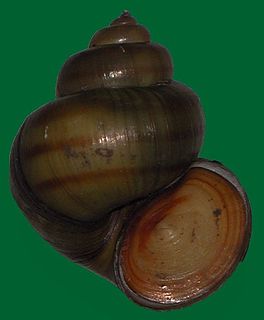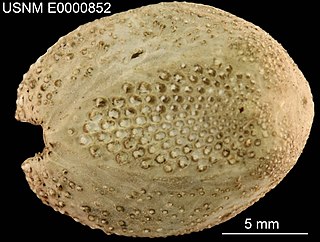
The Aspidodiadematidae are a family of sea urchins.

Viviparus, common name the river snails, is a genus of large, freshwater snails with an operculum, aquatic gastropod mollusks.

Melanopsis is a genus of freshwater snails with a gill and an operculum, aquatic gastropod mollusks in the family Melanopsidae.
The World Register of Marine Species (WoRMS) is a taxonomic database that aims to provide an authoritative and comprehensive list of names of marine organisms.

The Echinacea are a superorder of sea urchins. They are distinguished by the presence of a rigid test, with ten buccal plates around the mouth, and solid spines. Unlike some other sea urchins, they also possess gills. The group is a large one, with species found worldwide.

The Echinothurioida are an order of sea urchins in the class Echinoidea. Echinothurioids are distinguished from other sea urchins by the combination of a flexible test and hollow spines. The membrane around the mouth contains only simple plates, in contrast to the more complex mouth parts of their close relatives, the Diadematoida. They are nearly all deepsea dwellers.

The Camarodonta are an order of globular sea urchins in the class Echinoidea. The fossil record shows that camarodonts have been in existence since the Lower Cretaceous.

Aceste ovata is a species of sea urchin of the family Schizasteridae. Their armour is covered with spines. It came from the genus Aceste and lives in the sea. Aceste ovata was first scientifically described in 1907 by Alexander Emanuel Agassiz & Hubert Lyman Clark.
Aceste weberi is a species of sea urchin of the family Schizasteridae. Their armour is covered with spines. It came from the genus Aceste and lives in the sea. Aceste weberi was first scientifically described in 1914 by Koehler.

Aeropsis rostrata is a species of sea urchin of the family Aeropsidae. Their armour is covered with spines. It is placed in the genus Aeropsis and lives in the sea. Aeropsis rostrata was first scientifically described in 1877 by Thomson.
Araeosoma fenestratum is a species of sea urchin of the family Echinothuriidae. Their armour is covered with spines. It is placed in the genus Araeosoma and lives in the sea. Araeosoma fenestratum was first scientifically described in 1872 by Thomson.

Echinometra is a genus of sea urchins in the family Echinometridae.

Phormosoma placenta is a species of sea urchin in the order Echinothurioida. It is a deepwater species, seldom being found at depths less than 500 m (1,600 ft), and occurs on either side of the Atlantic Ocean on the continental slope.

Calveriosoma hystrix is a species of sea urchins of the Family Echinothuriidae. Their armour is covered with spines. Calveriosoma hystrix was first scientifically described in 1872 by Thomson.
Calymne relicta is a species of sea urchins of the Family Calymnidae. Their armour is covered with spines. Calymne relicta was first scientifically described in 1877 by Thomson.

The infraclassis Carinacea includes most living species of regular sea urchin, and fossil forms going back as far as the Triassic.

The Echinothuriidae are a family of sea urchins in the order Echinothurioida. Due to their soft skeletons, most are called "leather urchins", but species in the genus Asthenosoma are also known as "fire urchins" due to their bright colors and painful, venomous sting.

Araeosoma is a genus of deep-sea sea urchins in the family Echinothuriidae.
Schizasteridae is a family of echinoderms belonging to the order Spatangoida.
Aceste is a genus of echinoderms belonging to the family Schizasteridae.












